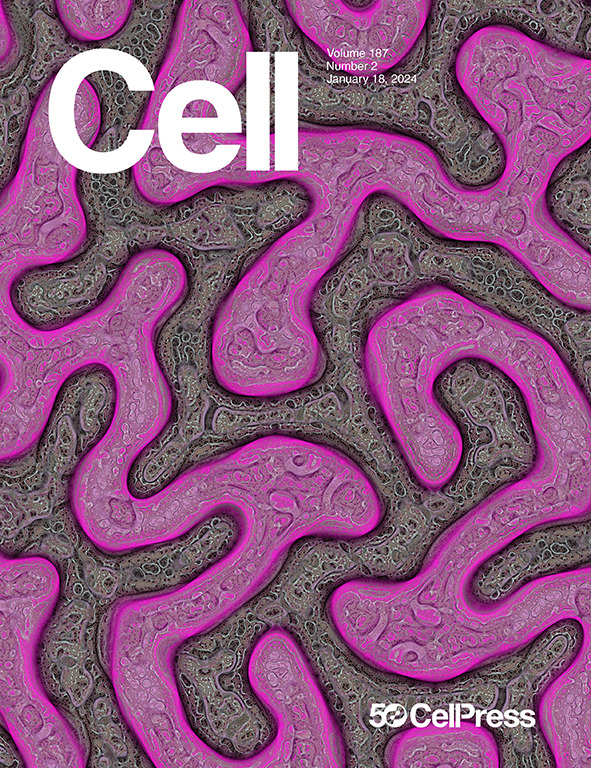由病毒蛋白触发的着丝粒DNA扩增激活核cGAS
IF 45.5
1区 生物学
Q1 BIOCHEMISTRY & MOLECULAR BIOLOGY
引用次数: 0
摘要
cGAS-cGAMP-STING通路对抗病毒免疫至关重要。当胞质cGAS检测病毒DNA时,大多数DNA病毒保护其基因组并侵入细胞核,而细胞核中的染色质限制了cGAS的激活。病毒如何激活核cGAS尚不清楚。在这里,我们展示了几种疱疹病毒蛋白通过扰乱cGAS富集的着丝粒来触发核cGAS激活。单纯疱疹病毒1型(HSV-1)泛素连接酶感染细胞蛋白0 (ICP0),降解着丝粒蛋白,在静止的单核细胞源性细胞中通过翻译DNA合成(TLS)途径促进着丝粒DNA扩增,从而激活核cGAS。在感染期间,HSV-1也通过表达UL36USP (TLS的抑制因子)来逃避这种检测。与ICP0类似,巨细胞病毒IE1蛋白引起着丝粒DNA扩增和cGAS激活。我们将这一机制定义为病毒诱导的着丝粒DNA扩增和识别(VICAR),揭示了着丝粒的非有丝分裂免疫激活作用。本文章由计算机程序翻译,如有差异,请以英文原文为准。

Centromeric DNA amplification triggered by viral proteins activates nuclear cGAS
The cGAS-cGAMP-STING pathway is crucial for antiviral immunity. While cytosolic cGAS detects viral DNA, most DNA viruses shield their genome and invade the nucleus, where chromatin restricts cGAS activation. How viruses may activate nuclear cGAS is not well understood. Here, we show that several herpesvirus proteins trigger nuclear cGAS activation by perturbing centromeres, where cGAS is enriched. The herpes simplex virus type 1 (HSV-1) ubiquitin ligase infected cell protein 0 (ICP0), which degrades centromeric proteins, promotes centromeric DNA amplification through the translesion DNA synthesis (TLS) pathway in quiescent monocyte-derived cells, thereby activating nuclear cGAS. During infection, HSV-1 evades this detection by also expressing UL36USP, a suppressor of TLS. Similarly to ICP0, the cytomegalovirus IE1 protein causes centromeric DNA amplification and cGAS activation. We define this mechanism as viral-induced centromeric DNA amplification and recognition (VICAR), uncovering a non-mitotic, immune-activating role of centromeres.
求助全文
通过发布文献求助,成功后即可免费获取论文全文。
去求助
来源期刊

Cell
生物-生化与分子生物学
CiteScore
110.00
自引率
0.80%
发文量
396
审稿时长
2 months
期刊介绍:
Cells is an international, peer-reviewed, open access journal that focuses on cell biology, molecular biology, and biophysics. It is affiliated with several societies, including the Spanish Society for Biochemistry and Molecular Biology (SEBBM), Nordic Autophagy Society (NAS), Spanish Society of Hematology and Hemotherapy (SEHH), and Society for Regenerative Medicine (Russian Federation) (RPO).
The journal publishes research findings of significant importance in various areas of experimental biology, such as cell biology, molecular biology, neuroscience, immunology, virology, microbiology, cancer, human genetics, systems biology, signaling, and disease mechanisms and therapeutics. The primary criterion for considering papers is whether the results contribute to significant conceptual advances or raise thought-provoking questions and hypotheses related to interesting and important biological inquiries.
In addition to primary research articles presented in four formats, Cells also features review and opinion articles in its "leading edge" section, discussing recent research advancements and topics of interest to its wide readership.
 求助内容:
求助内容: 应助结果提醒方式:
应助结果提醒方式:


